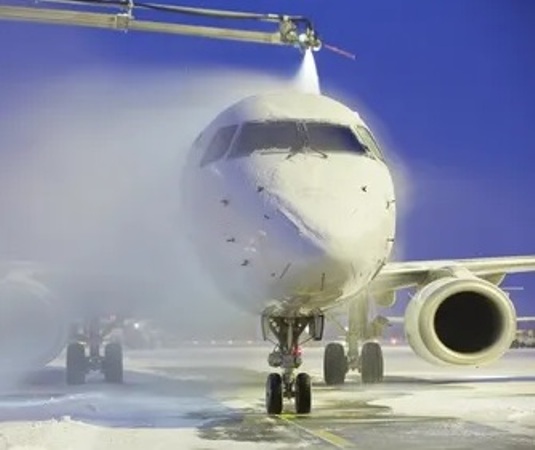
The aircraft de-icing market is a critical sector in the aviation industry, ensuring safe operations during adverse weather conditions. The aircraft de-icing market is expected to grow at a CAGR of 5.5% during the forecast period of 2025 to 2033. It plays a crucial role in ensuring aviation safety and efficiency. The market is driven by safety regulations, the global growth of air travel, and the challenges posed by climate change. However, environmental concerns surrounding de-icing fluids present a restraint that the industry must address. Competitive trends suggest that established players are well-positioned to meet the growing demand for efficient and environmentally friendly de-icing solutions in the aviation industry.

Safety and Regulatory Compliance
Safety is paramount in the aviation industry, and the need for effective de-icing solutions is driven by stringent regulatory requirements. National and international aviation authorities mandate that aircraft must be free of ice and snow before takeoff to prevent accidents and ensure passenger safety. Airlines and airport operators are continually investing in advanced de-icing technologies to comply with these regulations. Evidence for this driver can be found in the consistent enforcement of de-icing regulations and the focus on safety in the aviation industry.
Global Growth of Air Travel
The global increase in air travel, both for business and leisure, has spurred the demand for de-icing services. As more people choose air travel as their mode of transportation, airports and airlines are experiencing higher passenger volumes, especially in regions with extreme winter weather conditions. This has led to a growing need for efficient de-icing operations to prevent delays and ensure on-time departures. Evidence for this driver can be observed in the escalating number of flights and passengers at airports worldwide.
Climate Change and Weather Uncertainty
Climate change is causing unpredictable weather patterns, including severe winters in regions not historically accustomed to such conditions. These fluctuations result in increased ice and snow accumulation on aircraft. Consequently, airlines and airport authorities are facing the challenge of dealing with de-icing operations more frequently. The evidence for this driver can be found in the growing number of weather-related disruptions to air travel and the need for reliable de-icing solutions to mitigate these disruptions.
Environmental Concerns
While effective de-icing is essential for aviation safety, there is a growing concern about the environmental impact of de-icing fluids. The discharge of de-icing fluids, especially the glycol-based types, into water bodies and the surrounding environment can lead to ecological and water pollution issues. This has prompted regulatory bodies and environmental organizations to scrutinize de-icing operations and seek more environmentally friendly alternatives. Evidence for this restraint can be seen in the increasing scrutiny and regulations related to de-icing fluid disposal.
By Fluid Type (Type I, Type II, Type III, Type IV): Type IV de-icing fluid to Promise Significant Opportunities during the Forecast Period
In 2024, the aircraft de-icing market witnessed substantial revenue from Type I and Type II de-icing fluids. However, during the forecast period from 2025 to 2033, Type IV de-icing fluid is expected to exhibit the highest CAGR. This reflects the ongoing development of de-icing fluid technologies, with an emphasis on efficiency and safety.
By Method (Spray De-Icing, Chemical De-Icing, Infrared Heating, Other Methods): Spray De-icing Segment Dominates the Market
In 2024, various de-icing methods contributed to the market's revenue. Notably, spray de-icing generated the highest revenue in 2024. Looking ahead to the period from 2025 to 2033, chemical de-icing is projected to have the highest CAGR. This shift highlights the preference for chemical de-icing methods in ensuring efficient ice removal.
North America Remains the Global Leader
The aircraft de-icing market exhibits distinct geographic trends. In 2024, North America led in terms of revenue, contributing significantly to the market. The region with the highest revenue percentage in 2024 was North America. However, looking ahead to the period from 2025 to 2033, the Asia-Pacific region is expected to have the highest CAGR. This reflects the growth of air travel and the need for de-icing services in emerging aviation markets.
Market Competition to Intensify during the Forecast Period
In the competitive landscape of the aircraft de-icing market, top players such as B/E Aerospace, Inc., JBT Corporation, UTC Aerospace System, Vestergaard Co., Airport Equipment Co., Cox & Co., Weihai Guangtai, The Dow Chemical Co., Denge Airport Equipment, Laanga Industrial, Global Ground Support LLC, and Sdi Aviation have consistently demonstrated their expertise. These industry leaders reported substantial revenues in 2024, and their strategies for the forecast period from 2025 to 2033 are expected to focus on product innovation, environmental sustainability, and operational efficiency. Competition among these key players is intensifying, leading to advancements in de-icing technology and services.
Historical & Forecast Period
This study report represents analysis of each segment from 2023 to 2033 considering 2024 as the base year. Compounded Annual Growth Rate (CAGR) for each of the respective segments estimated for the forecast period of 2025 to 2033.
The current report comprises of quantitative market estimations for each micro market for every geographical region and qualitative market analysis such as micro and macro environment analysis, market trends, competitive intelligence, segment analysis, porters five force model, top winning strategies, top investment markets, emerging trends and technological analysis, case studies, strategic conclusions and recommendations and other key market insights.
Research Methodology
The complete research study was conducted in three phases, namely: secondary research, primary research, and expert panel review. key data point that enables the estimation of Aircraft De-icing market are as follows:
Market forecast was performed through proprietary software that analyzes various qualitative and quantitative factors. Growth rate and CAGR were estimated through intensive secondary and primary research. Data triangulation across various data points provides accuracy across various analyzed market segments in the report. Application of both top down and bottom-up approach for validation of market estimation assures logical, methodical and mathematical consistency of the quantitative data.
| ATTRIBUTE | DETAILS |
|---|---|
| Research Period | 2023-2033 |
| Base Year | 2024 |
| Forecast Period | 2025-2033 |
| Historical Year | 2023 |
| Unit | USD Million |
| Segmentation | |
Fluid Type
| |
Method
| |
Application
| |
|
Region Segment (2023-2033; US$ Million)
|
Key questions answered in this report